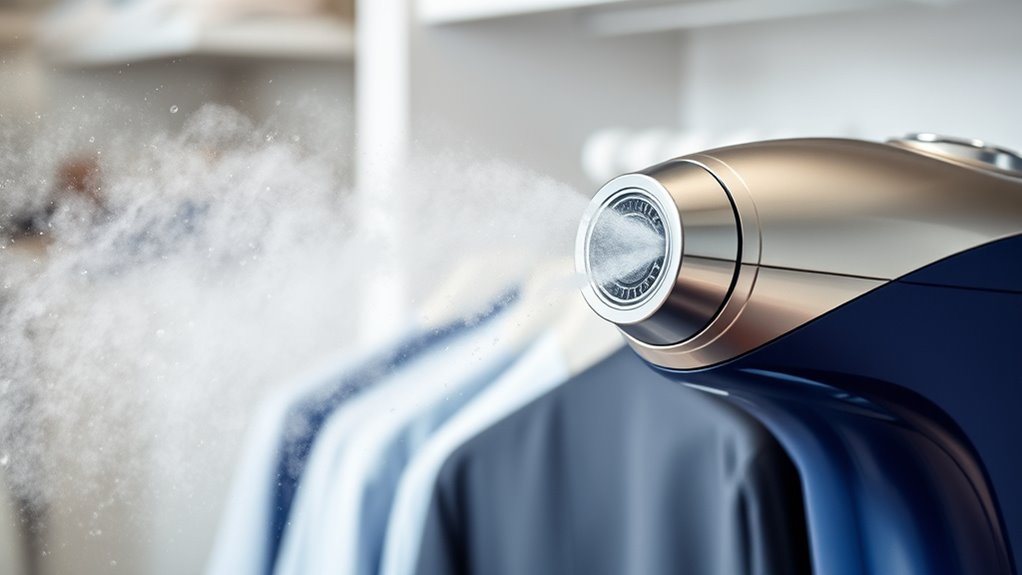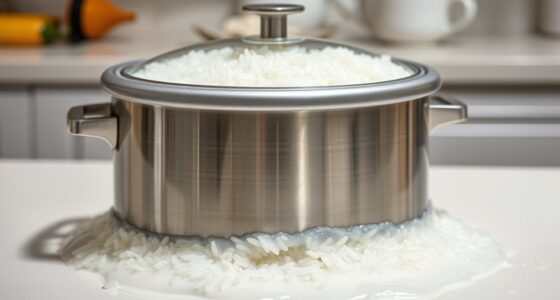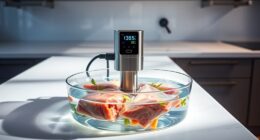If your garment steamer is spitting water, it’s likely caused by mineral deposits or clogs in the internal channels. Check that you’re using distilled or filtered water and avoid overfilling the tank. Regularly descale the device to remove buildup and clear any blockages in the steam outlet. Make sure the heating element is working correctly and the settings are appropriate. For more tips to fix the issue, keep exploring how to get steady steam again.
Key Takeaways
- Descale your steamer regularly using vinegar or commercial descaling agents to remove mineral buildup.
- Use filtered or distilled water to reduce mineral deposits and prevent clogging.
- Check and clean internal valves to ensure unobstructed steam flow.
- Maintain proper water levels and avoid overfilling to prevent excess water spitting.
- If issues persist after maintenance, seek professional repair for internal damage or faulty components.
Check for Mineral Buildup in Your Steamer
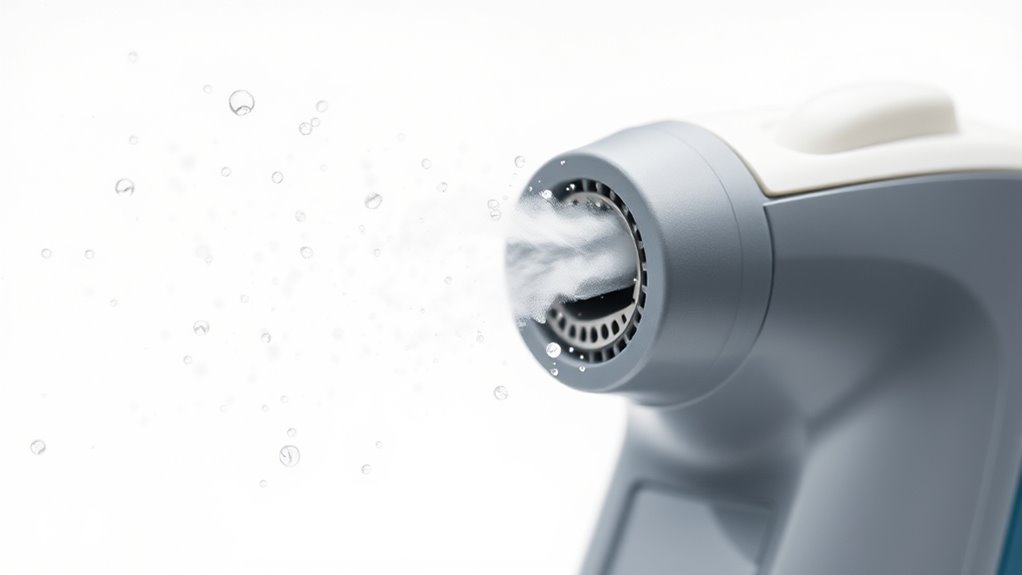
Mineral buildup is a common cause of a steamer spitting water, especially if you use tap water regularly. Over time, minerals from hard water can accumulate inside the unit, affecting steam pressure and performance. You might also notice detergent residue from previous cleaning or descaling efforts lingering in the tank, which can contribute to clogs and uneven steam output. These deposits block the pathways where steam is generated, causing inconsistent or excessive water spitting. To check for buildup, inspect the water tank and steam outlets for white or crusty deposits. If you spot any, it’s time to clean your steamer thoroughly. Removing these deposits restores proper steam pressure, reduces water spitting, and ensures your steamer works efficiently. Regular descaling can prevent hard water deposits from forming and keep your steamer functioning smoothly.
Ensure Proper Water Level and Quality
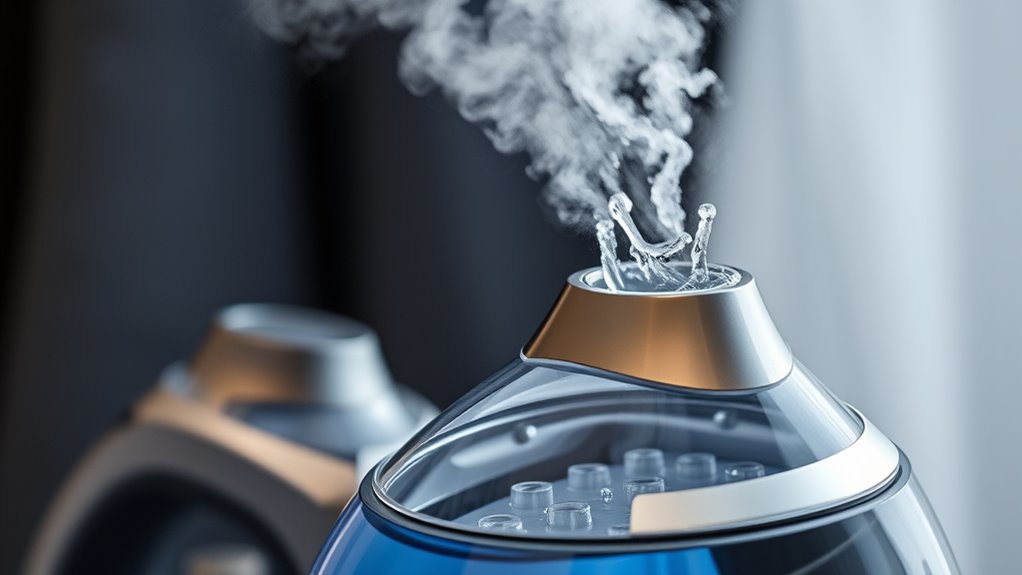
Using the right water level and quality can substantially reduce water spitting issues. Ensure you’re refilling the water tank to the recommended level; overfilling can cause excess water to escape. Use fresh, clean water for excellent results—distilled or filtered water often works best, as tap water with minerals can cause buildup. Automation technologies enable the development of smarter appliances, including steamers with features that help prevent spitting. To maintain steady steam:
- Regularly check and refill the water, avoiding overfilling
- Use water with low mineral content, like distilled or filtered water
- Keep the water level within the recommended range for your steamer
Proper water refilling and high water quality help prevent spitting, guaranteeing your steamer produces consistent, steady steam.
Clear Clogs in the Steam Outlet

Mineral buildup can cause your steam outlet to clog and spit water. To fix this, you should remove the deposits by using a vinegar solution. This simple step helps keep your steamer working smoothly and prevents future blockages. Regular maintenance and cleaning can also extend the lifespan of your garment steamer.
Remove Mineral Buildup
If your garment steamer is spitting water, mineral buildup in the steam outlet might be the culprit. Over time, minerals from tap water can accumulate, clogging the outlet and affecting steam quality. To remove this buildup:
- Descale with a mixture of water and vinegar to dissolve mineral deposits.
- Use distilled water to prevent future buildup.
- Check and adjust the steam temperature, as high heat can cause more mineral deposits to form.
- Regularly inspecting and cleaning the steam outlet can prevent clogs and maintain optimal performance for consistent steam delivery.
Avoid using fabric softeners in your water, as they can contribute to residue. Regular descaling and maintaining the proper steam temperature keep your steamer working efficiently. This not only reduces spitting but also prolongs your device’s life and ensures consistently steady steam.
Use Vinegar Solution
To clear clogs in your steam outlet, a vinegar solution is highly effective. Vinegar cleaning works as a natural descaling process that dissolves mineral deposits causing blockages. Fill your water reservoir with equal parts white vinegar and water, then turn on your steamer and let it run for a few minutes to allow the vinegar to circulate through the system. Afterward, empty the reservoir and refill it with clean water. Run the steamer again to flush out any remaining vinegar and loosened buildup. This simple descaling process helps remove stubborn mineral deposits, ensuring steady steam flow. Regular vinegar cleaning prevents future clogs and maintains your garment steamer’s performance. Just be sure to follow manufacturer instructions to avoid any damage. Additionally, understanding how mineral deposits accumulate can help you better prevent clogs in the future.
Adjust the Steamer’s Heating Element
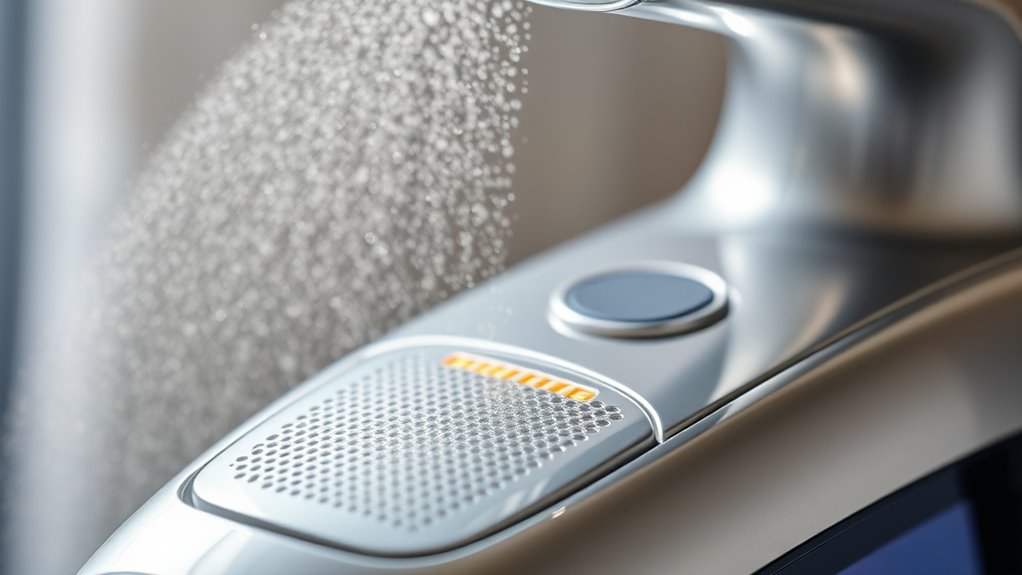
Adjusting the garment steamer’s heating element can often resolve water spitting issues by ensuring the right temperature is maintained. Proper adjustment helps with effective steam production and prevents excess water from escaping. To do this, you may need to adjust heating settings or calibrate the element to match manufacturer specifications. Ensuring the correct RMD can prevent overheating and maintain consistent steam output. Here are some tips:
- Check for any visible damage or buildup on the heating element.
- Follow the manufacturer’s instructions to adjust heating settings or perform element calibration.
- Test the steamer after adjustments to see if water spitting has stopped.
Verify the Correct Settings and Usage Instructions

Make sure you’ve set your steamer to the correct steam level before use. Follow the manufacturer’s instructions carefully to prevent water spitting. Properly operating your steamer helps make sure smooth, effective steaming without issues. Ensuring your device is clean and free of mineral buildup can also improve steaming performance.
Confirm Steam Settings
Have you double-checked your garment steamer’s settings before use? Ensuring the correct steam pressure and water temperature can prevent spitting water and deliver steady steam. First, verify that the steam pressure is set appropriately for your fabric, usually medium to high for stubborn wrinkles. Next, confirm the water temperature is hot enough to produce consistent steam without over-pressurizing. In conclusion, check the steam release settings—some models have adjustable controls for fine-tuning. Additionally, understanding creative practice can help you approach troubleshooting with a more innovative mindset, making it easier to find effective solutions.
Follow Proper Operating Steps
To guarantee your garment steamer works effectively and prevents water spitting, it’s essential to follow the proper operating steps carefully. Start by selecting the right fabric and preparing your garments accordingly. Check the steamer’s settings to match your fabric type; delicate fabrics need lower heat, while sturdy materials can handle higher steam. Always fill the water tank properly and allow the steamer to heat fully before use. Ensuring the correct air quality can also help in maintaining optimal performance of your steamer, as poor air quality may affect the device’s functioning. Proper preparation ensures consistent steam and minimizes spitting. Follow these steps for ideal results.
Perform Regular Maintenance and Descaling

Perform Regular Maintenance and Descaling. Regular maintenance and descaling are essential to keep your garment steamer functioning properly and prevent it from spitting water. Over time, mineral deposits can build up, affecting steam pressure and performance. To maintain steady steam, regularly descale your steamer using alternative cleaning methods like vinegar solutions or descaling tablets. This helps remove mineral buildup that causes spitting and inconsistent steam. Additionally, check and adjust the steam pressure to ensure ideal operation. Keep an eye on these key areas: descaling techniques, descale with vinegar or commercial descaling agents, clear mineral deposits from the water tank, and adjust steam pressure for smooth operation. Performing these simple steps will keep your steamer in top shape, ensuring steady, powerful steam every time.
When to Seek Professional Repair Services

You should consider seeking professional repair services when your garment steamer continues to spit water despite regular descaling and maintenance. Persistent issues often indicate internal damage or faulty components that you can’t fix on your own. A professional repair can diagnose problems like defective valves or clogged internal channels that cause water spitting. If repairs aren’t cost-effective or the device remains unreliable, exploring replacement options might be your best choice. Professional repair services can extend your steamer’s lifespan or confirm when it’s time to replace it entirely. Don’t ignore ongoing issues; timely repairs can save you money and frustration. When simple fixes don’t work, consulting a professional ensures your garment steamer functions properly again or guides you toward the most suitable replacement. Additionally, understanding the internal mechanisms and common faulty components can help you make informed decisions about repairs or replacements.
Frequently Asked Questions
Can Using Distilled Water Prevent Water Spitting Issues?
Yes, using distilled water can prevent water spitting issues. Since distilled water has fewer minerals, it reduces mineral buildup inside your steamer, which often causes spitting or inconsistent steam. Poor water quality with minerals can clog the device and lead to water spitting. By switching to distilled water, you help maintain peak performance, keep your steamer cleaner longer, and enjoy steady, continuous steam without interruptions.
How Often Should I Descale My Garment Steamer?
You should descale your garment steamer every 1 to 3 months, depending on your water quality. If you use hard water, descale more frequently to prevent mineral buildup that causes spitting and uneven steam. Regular descaling maintains peak performance and extends your steamer’s lifespan. Always follow your manufacturer’s instructions for descaling frequency, and consider using distilled water to reduce mineral deposits and keep your steamer working smoothly.
Is It Normal for Steamers to Spit Water During Use?
It’s common for steamers to spit water during use, especially if the steam output is inconsistent. This usually happens due to water condensation inside the tank or nozzle, creating excess droplets that escape as spitting. To reduce this, make certain you’re using clean, distilled water, and avoid overfilling the tank. Regularly descaling your steamer helps maintain steady steam, minimizing water spitting and improving overall performance.
What Safety Precautions Should I Take When Repairing My Steamer?
Imagine sparks flying and chaos erupting—safety first! When repairing your steamer, always unplug it immediately to prevent electrical safety hazards. Use insulated tools and handle components carefully, avoiding water contact with electrical parts. Wear protective gloves and eye gear to shield yourself from unexpected splashes or debris. Remember, proper tool handling and caution keep you safe from electrical shocks and damage, making repairs safe and stress-free.
Can Changing Water Type Affect Steamer Performance?
Changing water type can definitely affect your steamer’s performance. Using hard water with high mineral content leads to mineral deposits, which clog the steamer and reduce steam quality. Select distilled or filtered water to minimize mineral buildup, ensuring steady, consistent steam. Regular descaling also helps prevent clogging and keeps your steamer working efficiently. So, choosing the right water type is key to maintaining ideal performance.
Conclusion
A steamer that spits water can be frustrating, but with careful maintenance, you can restore its steady steam. Think of it like tuning a musical instrument—you need to remove the buildup and adjust the settings. Ignoring the issue might seem easier, but it risks damaging your steamer and wasting time. Taking small steps now guarantees smooth steaming later. After all, a well-maintained steamer is like a reliable friend—always ready when you need it most.
